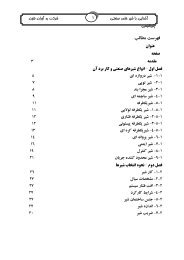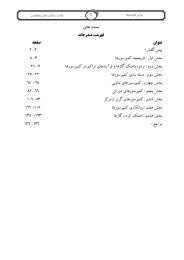Chapter 11 FUNDAMENTALS OF THERMAL RADIATION
Chapter 11 FUNDAMENTALS OF THERMAL RADIATION
Chapter 11 FUNDAMENTALS OF THERMAL RADIATION
You also want an ePaper? Increase the reach of your titles
YUMPU automatically turns print PDFs into web optimized ePapers that Google loves.
http://www.Drshokuhi.comسایت آموزش مهندسی مکانیک
<strong>Chapter</strong> <strong>11</strong><strong>Chapter</strong> <strong>11</strong> Fundamentals of Thermal Radiation<strong>FUNDAMENTALS</strong> <strong>OF</strong> <strong>THERMAL</strong> <strong>RADIATION</strong>Electromagnetic and Thermal Radiation<strong>11</strong>-1C Electromagnetic waves are caused by accelerated charges or changing electric currents giving rise toelectric and magnetic fields. Sound waves are caused by disturbances. Electromagnetic waves can travel invacuum, sound waves cannot.<strong>11</strong>-2C Electromagnetic waves are characterized by their frequency v and wavelength . These twoproperties in a medium are related by c / v where c is the speed of light in that medium.<strong>11</strong>-3C Visible light is a kind of electromagnetic wave whose wavelength is between 0.40 and 0.76 m. Itdiffers from the other forms of electromagnetic radiation in that it triggers the sensation of seeing in thehuman eye.<strong>11</strong>-4C Infrared radiation lies between 0.76 and 100 m whereas ultraviolet radiation lies between thewavelengths 0.01 and 0.40 m. The human body does not emit any radiation in the ultraviolet regionsince bodies at room temperature emit radiation in the infrared region only.<strong>11</strong>-5C Thermal radiation is the radiation emitted as a result of vibrational and rotational motions ofmolecules, atoms and electrons of a substance, and it extends from about 0.1 to 100 m in wavelength.Unlike the other forms of electromagnetic radiation, thermal radiation is emitted by bodies because of theirtemperature.<strong>11</strong>-6C Light (or visible) radiation consists of narrow bands of colors from violet to red. The color of asurface depends on its ability to reflect certain wavelength. For example, a surface that reflects radiation inthe wavelength range 0.63-0.76 m while absorbing the rest appears red to the eye. A surface that reflectsall the light appears white while a surface that absorbs the entire light incident on it appears black. Thecolor of a surface at room temperature is not related to the radiation it emits.<strong>11</strong>-7C Radiation in opaque solids is considered surface phenomena since only radiation emitted by themolecules in a very thin layer of a body at the surface can escape the solid.<strong>11</strong>-8C Because the snow reflects almost all of the visible and ultraviolet radiation, and the skin is exposedto radiation both from the sun and from the snow.<strong>11</strong>-1
<strong>Chapter</strong> <strong>11</strong> Fundamentals of Thermal Radiation<strong>11</strong>-9C Microwaves in the range of 10 2 to 10 5 m are very suitable for use in cooking as they are reflectedby metals, transmitted by glass and plastics and absorbed by food (especially water) molecules. Thus theelectric energy converted to radiation in a microwave oven eventually becomes part of the internal energyof the food with no conduction and convection thermal resistances involved. In conventional cooking, onthe other hand, conduction and convection thermal resistances slow down the heat transfer, and thus theheating process.<strong>11</strong>-10 Electricity is generated and transmitted in power lines at a frequency of 60 Hz. The wavelength ofthe electromagnetic waves is to be determined.Analysis The wavelength of the electromagnetic waves is 8c 2. 998 10m / s 4.997 10 6 mv 60 Hz(1/ s)Power lines<strong>11</strong>-<strong>11</strong> A microwave oven operates at a frequency of 2.810 9 Hz. The wavelength of these microwaves andthe energy of each microwave are to be determined.Analysis The wavelength of these microwaves is 8c 2.998 10m / s 0107 . m 107 mm9v 2.8 10Hz(1/ s)Then the energy of each microwave becomesMicrowaveoven34 8hc ( 6. 62510 Js )( 2. 998 10m / s)24e hv 1.86 10 J0107 . m<strong>11</strong>-12 A radio station is broadcasting radiowaves at a wavelengthof 200 m. The frequency of these waves is to be determined.Analysis The frequency of the waves is determined from cvc 2.99810v 200m8m/s 1.5 106Hz<strong>11</strong>-13 A cordless telephone operates at a frequency of 8.510 8 Hz. Thewavelength of these telephone waves is to be determined.Analysis The wavelength of the telephone waves is 8c 2.998 10m / s 0.35 m 350 mm8v 85 . 10Hz(1/ s)<strong>11</strong>-2
<strong>Chapter</strong> <strong>11</strong> Fundamentals of Thermal RadiationBlackbody Radiation<strong>11</strong>-14C A blackbody is a perfect emitter and absorber of radiation. A blackbody does not actually exist. Itis an idealized body that emits the maximum amount of radiation that can be emitted by a surface at a giventemperature.<strong>11</strong>-15C Spectral blackbody emissive power is the amount of radiation energy emitted by a blackbody at anabsolute temperature T per unit time, per unit surface area and per unit wavelength about wavelength .The integration of the spectral blackbody emissive power over the entire wavelength spectrum gives thetotal blackbody emissive power,0E ( T) E ( T)d Tbb4The spectral blackbody emissive power varies with wavelength, the total blackbody emissive power doesnot.<strong>11</strong>-16C We defined the blackbody radiation function f because the integrationE b ( T ) dcannot be0performed. The blackbody radiation function f represents the fraction of radiation emitted from ablackbody at temperature T in the wavelength range from = 0 to . This function is used to determinethe fraction of radiation in a wavelength range between and .1 2<strong>11</strong>-17C The larger the temperature of a body , the larger the fraction of the radiation emitted in shorterwavelengths. Therefore, the body at 1500 K will emit more radiation in the shorter wavelength region. Thebody at 1000 K emits more radiation at 20 m than the body at 1500 K since T constant .<strong>11</strong>-3
<strong>Chapter</strong> <strong>11</strong> Fundamentals of Thermal Radiation<strong>11</strong>-18 An isothermal cubical body is suspended in the air. The rate at which the cube emits radiationenergy and the spectral blackbody emissive power are to be determined.Assumptions The body behaves as a black body.Analysis (a) The total blackbody emissive power is determined from Stefan-Boltzman Law to be2A s4b A s 6a 6(0.2 ) 0.24 mE ( T) T2 (5.671028W/m(b) The spectral blackbody emissive power at a wavelength of 4m is determined from Plank's distribution law,2.K44)(1000K) (0.24 m ) 1.3610W24E b C15 C2 exp T 10.3kW/m 2 μm1(4 m)3.7431058Wm/m 4 1.438710mKexp 1 (4 m)(1000K) 42T = 1000 K20 cm20 cm20 cm<strong>11</strong>-19E The sun is at an effective surface temperature of 10,372 R. The rate of infrared radiation energyemitted by the sun is to be determined.Assumptions The sun behaves as a black body.Analysis Noting that T = 10,400 R = 5778 K, the blackbody radiation functionscorresponding to 1Tand 2 T are determined from Table <strong>11</strong>-2 to be T (0.76 m)(5778K)= 4391.3mK1 T (100m)(5778K)= 577,800mK2ff12 0.547370 1.0SUNT = 10,400 RThen the fraction of radiation emitted between these two wavelengths becomesf f 1.0 0.547 0.453 (or 45.3%) 21The total blackbody emissive power of the sun is determined from Stefan-Boltzman Law to beE b T482 ( 0.171410Btu/h.ft .R )(10,400R) 2.00510447Btu/h.ft2Then,Einfrared7 2 (0.451) E (0.453)(2.00510Btu/h.ft ) 9.08106 Btu/h.ft 2b<strong>11</strong>-4
<strong>Chapter</strong> <strong>11</strong> Fundamentals of Thermal Radiation<strong>11</strong>-20E "!PROBLEM <strong>11</strong>-20""GIVEN"T=5780 "[K]""lambda=0.01[micrometer], parameter to be varied""ANALYSIS"E_b_lambda=C_1/(lambda^5*(exp(C_2/(lambda*T))-1))C_1=3.742E8 "[W-micrometer^4/m^2]"C_2=1.439E4 "[micrometer-K]" [micrometer] E b, [W/m 2 -micrometer]0.01 2.820E-9010.<strong>11</strong> 1268420.21 846.330.31 170.840.41 54.6350.51 22.5260.62 10.9170.72 5.90580.82 3.46990.92 2.17…………909.1 0.0002198919.2 0.0002103929.3 0.0002013939.4 0.0001928949.5 0.0001847959.6 0.000177969.7 0.0001698979.8 0.0001629989.9 0.00015631000 0.000150<strong>11</strong>1-5
<strong>11</strong>-6<strong>Chapter</strong> <strong>11</strong> Fundamentals of Thermal Radiation
<strong>Chapter</strong> <strong>11</strong> Fundamentals of Thermal Radiation<strong>11</strong>-21 The temperature of the filament of an incandescent light bulb is given. The fraction of visibleradiation emitted by the filament and the wavelength at which the emission peaks are to be determined.Assumptions The filament behaves as a black body.Analysis The visible range of the electromagnetic spectrum extends from 040 . m to 076 . m .1 2Noting that T = 3200 K, the blackbody radiation functions corresponding to 1Tand 2 T are determinedfrom Table <strong>11</strong>-2 to be T ( 0. 40 m)(3200 K) = 1280 mKf 0.00439641 T ( 0. 76 m)(3200 K) = 2432 mKf 0147<strong>11</strong>4 .212T = 3200 KThen the fraction of radiation emitted between these two wavelengths becomesf f 0.147<strong>11</strong>4240. 0043964 0.142718 (or 14.3%)2 1The wavelength at which the emission of radiation from the filament is maximum is( T ) maxpower 2897.8 m K maxpower2897.8 m K 0.905mm3200K<strong>11</strong>-7
<strong>Chapter</strong> <strong>11</strong> Fundamentals of Thermal Radiation<strong>11</strong>-22 "!PROBLEM <strong>11</strong>-22""GIVEN""T=3200 [K], parameter to be varied"lambda_1=0.40 "[micrometer]"lambda_2=0.76 "[micrometer]""ANALYSIS"E_b_lambda=C_1/(lambda^5*(exp(C_2/(lambda*T))-1))C_1=3.742E8 "[W-micrometer^4/m^2]"C_2=1.439E4 "[micrometer-K]"f_lambda=integral(E_b_lambda, lambda, lambda_1, lambda_2)/E_bE_b=sigma*T^4sigma=5.67E-8 "[W/m^2-K^4], Stefan-Boltzmann constant"T [K]f 1000 0.0000073531200 0.00010321400 0.00064031600 0.0024051800 0.0065052000 0.014042200 0.025762400 0.041982600 0.062482800 0.086713000 0.<strong>11</strong>393200 0.1433400 0.17323600 0.20363800 0.23364000 0.2623<strong>11</strong>-8
<strong>Chapter</strong> <strong>11</strong> Fundamentals of Thermal Radiation<strong>11</strong>-23 An incandescent light bulb emits 15% of its energy at wavelengthsshorter than 1 m. The temperature of the filament is to be determined.Assumptions The filament behaves as a black body.Analysis From the Table <strong>11</strong>-2 for the fraction of the radiation, we readT = ?f 0.15T 2445mKFor the wavelength range of 00 . m to 1.0 m1 2 = 1mT 2445mKT 2445K<strong>11</strong>-9
<strong>Chapter</strong> <strong>11</strong> Fundamentals of Thermal Radiation<strong>11</strong>-24 Radiation emitted by a light source is maximum in the blue range. The temperature of this lightsource and the fraction of radiation it emits in the visible range are to be determined.Assumptions The light source behaves as a black body.Analysis The temperature of this light source is( T) max power2897.8 mK 2897.8 mKT 6166K0.47mThe visible range of the electromagnetic spectrum extends from .40m to 0.76 m . Noting that T = 6166 K, the blackbody1 0 2 radiation functions corresponding to 1Tand 2 T are determined fromTable <strong>11</strong>-2 to be T (0.40m)(6166K)= 2466mKf1 T (0.76m)(6166K)= 4686mKf212 0.15444 0.59141Then the fraction of radiation emitted between these two wavelengths becomesf f 0.591410. 15444 0.437 (or 43.7%)21T = ?<strong>11</strong>-25 A glass window transmits 90% of the radiation in a specified wavelength range and is opaque forradiation at other wavelengths. The rate of radiation transmitted through this window is to be determinedfor two cases.Assumptions The sources behave as a black body.Analysis The surface area of the glass window is2A s 4 m(a) For a blackbody source at 5800 K, the total blackbody radiation emission is4b A sE ( T) T (5.67108The fraction of radiation in the range of 0.3 to 3.0 m is T (0.30m)(5800K)= 1740mKf1 T (3.0 m)(5800K)= 17,400mKf2f f f21 0.978750.033450.9453244kW/m .K) (5800K) (4 m ) 2.56710kW122 0.03345 0.97875Noting that 90% of the total radiation is transmitted throughthe window,Etransmit 0.90fEb( T ) (0.90)(0.9453)(2.567105kW) 2.184105kW(b) For a blackbody source at 1000 K, the total blackbody emissive power is4b A sE ( T ) T (5.67108W/mThe fraction of radiation in the visible range of 0.3 to 3.0 m isand2.K T (0.30m)(1000K)= 300mKf1 T (3.0 m)(1000K)= 3000mKf2f f f21Etransmitb 0.273232044)(1000K) (4 m ) 226.8 kW12 0.00002 0.273232 0.90fE( T) (0.90)(0.273232)(226.8 kW) 55.8kW5L = 2 mSUNGlass = 0.9<strong>11</strong>-10
<strong>Chapter</strong> <strong>11</strong> Fundamentals of Thermal RadiationRadiation Intensity<strong>11</strong>-26C A solid angle represents an opening in space, whereas a plain angle represents an opening in aplane. For a sphere of unit radius, the solid angle about the origin subtended by a given surface on thesphere is equal to the area of the surface. For a cicle of unit radius, the plain angle about the originsubtended by a given arc is equal to the length of the arc. The value of a solid angle associated with asphere is 4.<strong>11</strong>-27C The intensity of emitted radiation I e (, ) is defined as the rate at which radiation energy dQ e isemitted in the (, ) direction per unit area normal to this direction and per unit solid angle about thisdirection. For a diffusely emitting surface, the emissive power is related to the intensity of emitted radiationby E I (or E I,e for spectral quantities).e<strong>11</strong>-28C Irradiation G is the radiation flux incident on a surface from all directions. For diffusely incidentradiation, irradiation on a surface is related to the intensity of incident radiation by G I (orG I,i for spectral quantities).i<strong>11</strong>-29C Radiosity J is the rate at which radiation energy leaves a unit area of a surface by emission andreflection in all directions.. For a diffusely emitting and reflecting surface, radiosity is related to theintensity of emitted and reflected radiation by J (or J I ,erfor spectral quantities).I e r<strong>11</strong>-30C When the variation of a spectral radiation quantity with wavelength is known, the correcpondingtotal quantity is determined by integrating that quantity with respect to wavelength from = 0 to = .<strong>11</strong>-<strong>11</strong>
<strong>Chapter</strong> <strong>11</strong> Fundamentals of Thermal Radiation<strong>11</strong>-31 A surface is subjected to radiation emitted by another surface. The solid angle subtended and the rateat which emitted radiation is received are to be determined.Assumptions 1 Surface A 1 emits diffusely as a blackbody. 2 Both A 1 and A 2 can be approximated asdifferential surfaces since both are very small compared to the square of the distance between them.Analysis Approximating both A 1 and A 2 as differentialsurfaces, the solid angle subtended by A 2 when viewed from A 1can be determined from Eq. <strong>11</strong>-12 to beA 2 = 4 cm 221A n ,2r2A cos2r222(4 cm ) cos60 3.125 102(80cm)4sr 2 = 60since the normal of A 2 makes 60 with the direction ofviewing. Note that solid angle subtended by A 2 would bemaximum if A 2 were positioned normal to the direction ofviewing. Also, the point of viewing on A 1 is taken to be a pointin the middle, but it can be any point since A 1 is assumed to bevery small.The radiation emitted by A 1 that strikes A 2 isequivalent to the radiation emitted by A 1 through the solidangle 2-1 . The intensity of the radiation emitted by A 1 is 1 = 45A 1 = 4 cm 2T 1 = 600 Kr = 80 cm48Eb( T1) T1(5.6710W/m K)(800K)2I1 7393W/m sr 2This value of intensity is the same in all directions since a blackbody is a diffuse emitter. Intensityrepresents the rate of radiation emission per unit area normal to the direction of emission per unit solidangle. Therefore, the rate of radiation energy emitted by A 1 in the direction of 1 through the solid angle 2-1 is determined by multiplying I 1 by the area of A 1 normal to 1 and the solid angle 2-1 . That is,Q 12 I1(A1cos ) (7393W/m 6.534 1012421sr)(410W4cos 45m244)(3.12510Therefore, the radiation emitted from surface A 1 will strike surface A 2 at a rate of 6.53410 -4 W.If A 2 were directly above A 1 at a distance 80 cm, 1 = 0 and the rate of radiation energy emitted by A 1becomes zero.4sr)<strong>11</strong>-12
<strong>Chapter</strong> <strong>11</strong> Fundamentals of Thermal Radiation<strong>11</strong>-34 A small surface emits radiation. The rate of radiation energy emitted through a band is to bedetermined.60Assumptions Surface A emits diffusely as a blackbody.Analysis The rate of radiation emission from a surface per unit surfacearea in the direction (,) is given asdQedE I e ( ,)cossin dddAThe total rate of radiation emission through the bandbetween 60 and 45 can be expressed asE2 060e 45I ( ,) cossin dd Ib T4 4 T4 4since the blackbody radiation intensity is constant (I b = constant), and260cossin 2 0 d d 456045cossin d (sin4260sin245) / 4Approximating a small area as a differential area, the rate of radiation energy emitted from an area of 1 cm 2in the specified band becomes45A = 1 cm 2T = 1500 KQ eT EdA 44(5.6710dA 82W/m K44)(1500K)4(<strong>11</strong>042m ) 7.18 W<strong>11</strong>-15
<strong>Chapter</strong> <strong>11</strong> Fundamentals of Thermal Radiation<strong>11</strong>-35 A small surface is subjected to uniform incident radiation. The rates of radiation emission throughtwo specified bands are to be determined.Assumptions The intensity of incident radiation is constant.Analysis (a) The rate at which radiation is incident on a surface perunit surface area in the direction (,) is given asdQidG I i ( ,) cossin dddAThe total rate of radiation emission through the bandbetween 0 and 45 can be expressed asG12 045I ( ,) cossin ddi I i 0since the incident radiation is constant (I i = constant), and245cossin 2 0 d d 04502cossin d (sin245sin20) / 2Approximating a small area as a differential area, the rate of radiation energy emitted from an area of 1 cm 2in the specified band becomes4Qi, 1 G1dA 0.5IidA 0.5(2.210W/m2sr)(<strong>11</strong>042m ) 3.46 W45A = 1 cm 2(b) Similarly, the total rate of radiation emission through theband between 45 and 90 can be expressed assince290G12 090I ( ,) cossin ddi I i 45cossin 2 0 d d 45and90452cossin d (sin4Qi, 2 G2dA 0.5IidA 0.5(2.210W/m22sr)(<strong>11</strong>090sin42245) / 2m ) 3.46 W9045A = 1 cm 2Discussion Note that the viewing area for the band 0 - 45 is much smaller, but the radiation energyincident through it is equal to the energy streaming through the remaining area.<strong>11</strong>-16
<strong>Chapter</strong> <strong>11</strong> Fundamentals of Thermal RadiationRadiation Properties<strong>11</strong>-36C The emissivity is the ratio of the radiation emitted by the surface to the radiation emitted by ablackbody at the same temperature. The fraction of radiation absorbed by the surface is called theabsorptivity ,( )( T) E TE ( T)and absorbed radiationincident radiationbWhen the surface temperature is equal to the temperature of the source of radiation, the total hemisphericalemissivity of a surface at temperature T is equal to its total hemispherical absorptivity for radiationcoming from a blackbody at the same temperature ( T) ( T).GabsG<strong>11</strong>-37C The fraction of irradiation reflected by the surface is called reflectivity and the fractiontransmitted is called the transmissivity G GrefandGtr GSurfaces are assumed to reflect in a perfectly spectral or diffuse manner for simplicity. In spectral (ormirror like) reflection, the angle of reflection equals the angle of incidence of the radiation beam. In diffusereflection, radiation is reflected equally in all directions.<strong>11</strong>-38C A body whose surface properties are independent of wavelength is said to be a graybody. Theemissivity of a blackbody is one for all wavelengths, the emissivity of a graybody is between zero and one.<strong>11</strong>-39C The heating effect which is due to the non-gray characteristic of glass, clear plastic, or atmosphericgases is known as the greenhouse effect since this effect is utilized primarily in greenhouses. Thecombustion gases such as CO 2 and water vapor in the atmosphere transmit the bulk of the solar radiationbut absorb the infrared radiation emitted by the surface of the earth, acting like a heat trap. There is aconcern that the energy trapped on earth will eventually cause global warming and thus drastic changes inweather patterns.<strong>11</strong>-40C Glass has a transparent window in the wavelength range 0.3 to 3 m and it is not transparent tothe radiation which has wavelength range greater than 3 m. Therefore, because the microwaves are in therange of 10 2 to 10 5 m, the harmful microwave radiation cannot escape from the glass door.<strong>11</strong>-17
<strong>Chapter</strong> <strong>11</strong> Fundamentals of Thermal Radiation<strong>11</strong>-41 The variation of emissivity of a surface at a specified temperature with wavelength is given. Theaverage emissivity of the surface and its emissive power are to be determined.Analysis The average emissivity of the surface can bedetermined from (T ) <strong>11</strong> f101 0- f1E1b( T ) d4T+ f+ ( f22 -2<strong>11</strong>T+ f2 f212Eb3 -2( T ) d) + (1 f342)32EbT( T ) d40.70.40.3where fand f1 2are blackbody radiation functionscorresponding to T and T , determined from1 2 T ( 2 m)(1000 K) = 2000 mKf 0.0667281 T ( 6 m)(1000 K) = 6000 mKf 0.7378182f f f f since f 0 and f f f since f 1.01 1 0 1 02 2122 6, mand, (0.4)0.066728(0.7)(0.7378180.066728) (0.3)(1 0.737818) 0.575Then the emissive power of the surface becomesE T4 0.575(5.671082 44W/m.K)(1000K)2 32.6 kW/m<strong>11</strong>-18
<strong>Chapter</strong> <strong>11</strong> Fundamentals of Thermal Radiation<strong>11</strong>-42 The variation of reflectivity of a surface withwavelength is given. The average reflectivity,emissivity, and absorptivity of the surface are to bedetermined for two source temperatures. Analysis The average reflectivity of this surface forsolar radiation ( T = 5800 K) is determined to beT ( 3 m)(5800 K) = 17400 mK f 0978746 .0.95( T) f ( T) f ( T)1 02 f ( 1f )1 2 ( 0. 35)( 0. 978746) ( 0. 95)( 10. 978746) 0.3621 <strong>11</strong> 1Noting that this is an opaque surface, 00.353, mAt T = 5800 K: 1 1 10. 362 0.638Repeating calculations for radiation coming from surfaces at T = 300 K,T ( 3 00001685 .m)(300 K) = 900 mK f10.95 (T) (0.35)(0.0001685) (0.95)(1 0.0001685)At T = 300 K: 1 1 10. 95 0.05and 0.05The temperature of the aluminum plate is close to room temperature, and thus emissivity of the plate willbe equal to its absorptivity at room temperature. That is, room 0.05 0.638swhich makes it suitable as a solar collector. ( s 1and room 0 for an ideal solar collector)<strong>11</strong>-43 The variation of transmissivity of the glass window of a furnace at a specified temperature withwavelength is given. The fraction and the rate of radiation coming from the furnace and transmittedthrough the window are to be determined.Assumptions The window glass behaves as a black body.Analysis The fraction of radiation at wavelengthssmaller than 3 m isT ( 3 m)(1200 K) = 3600 mK f 0.403607The fraction of radiation coming from the furnace andtransmitted through the window is ( T)1 f 2 (1f ) (0.7)(0.403607) (0)(1 0.403607) 0.2833Then the rate of radiation coming from the furnace and transmitted through the window becomes , mG trAT4 0.283(0.250.25m2)(5.6710 0.782 44W/m.K)(1200K) 2076 W<strong>11</strong>-19
<strong>Chapter</strong> <strong>11</strong> Fundamentals of Thermal Radiation<strong>11</strong>-44 The variation of emissivity of a tungsten filament with wavelength is given. The average emissivity,absorptivity, and reflectivity of the filament are to be determined for two temperatures.Analysis (a) T = 2000 K1T (1 m)(2000K)= 2000mKf 0.0667281The average emissivity of this surface is(T) f (1 f1 1 2 (0.5)(0.066728) (0.15)(1 0.066728) 0.173From Kirchhoff’s law, 0.173 (at 2000 K)and1)0.5 0.15 1 1 10. 173 0.827(b) T = 3000 KThen1T ( 1 m)(3000 K) = 3000 mK f 0273232 .(T) f (1 f1 1 2 (0.5)(0.273232) (0.15)(1 0.273232) 0.246From Kirchhoff’s law, 0.246 (at 3000 K)and 1 1 10. 246 0.7541)<strong>11</strong>, m<strong>11</strong>-20
<strong>Chapter</strong> <strong>11</strong> Fundamentals of Thermal Radiation<strong>11</strong>-45 The variations of emissivity of two surfaces are given. The average emissivity, absorptivity, andreflectivity of each surface are to be determined at the given temperature.Analysis For the first surface:1T ( 3 m)(3000 K) = 9000 mK f 0890029 .1The average emissivity of this surface is(T) 1 f (1 f (0.2)(0.890029) (0.9)(1 0.890029) 0.281 21)The absorptivity and reflectivity are determined from Kirchhoff’s law 0.28(at 3000K) 1 1 10.28 0.72For the second surface:1T ( 3 m)(3000 K) = 9000 mK f 0890029 .The average emissivity of this surface is1 0.80.230.90.1, mThen,(T) 1 f (1 f (0.8)(0.890029) (0.1)(1 0.890029) 0.72 1 20.721 1 1 10.72 0.28)(at 3000K)Discussion The second surface is more suitable to serve as a solar absorber since its absorptivity for shortwavelength radiation (typical of radiation emitted by a high-temperature source such as the sun) is high,and its emissivity for long wavelength radiation (typical of emitted radiation from the absorber plate) islow.<strong>11</strong>-21
<strong>Chapter</strong> <strong>11</strong> Fundamentals of Thermal Radiation<strong>11</strong>-46 The variation of emissivity of a surface with wavelength is given. The average emissivity andabsorptivity of the surface are to be determined for two temperatures.Analysis (a) For T = 5800 K: T (5 m)(5800 K) = 29,000 mK f 099534 .1 1The average emissivity of this surface is(T ) f(1 f1 1 2 (0.2)(0.99534) (0.9)(1 0.99534) 0.203(b) For T = 300 K:1) 0.5 T (5 m)(300 K) =1500 mK f 0013754 .and1 1(T) f (0.2)(0.013754) (0.9)(1 0.013754) 0.89(1 f1 1 21)The absorptivities of this surface for radiation coming from sources at 5800 K and 300 K are, fromKirchhoff’s law, 0.203 (at 5800 K) 0.89 (at 300 K)0.25, m<strong>11</strong>-47 The variation of absorptivity of a surface with wavelength is given. The average absorptivity,reflectivity, and emissivity of the surface are to be determined at given temperatures.Analysis For T = 2500 K:1T ( 2 m)(2500 K) = 5000 mK f 0633747 .1The average absorptivity of this surface is(T ) f(1 f1 1 2 (0.2)(0.633747) (0.7)(1 0.633747) 0.38Then the reflectivity of this surface becomes 1 1 10. 38 0.621) 0.70.2Using Kirchhoff’s law, , the average emissivityof this surface at T = 3000 K is determined to beT ( 2m)(3000 K) = 6000 mK f 0.737818(T) 1 f (1 f1 21 (0.2)(0.737818) (0.7)(1 0.737818) 0.33)2, m<strong>11</strong>-22
<strong>Chapter</strong> <strong>11</strong> Fundamentals of Thermal Radiation<strong>11</strong>-48E A spherical ball emits radiation at a certain rate. The averageemissivity of the ball is to be determined at the given temperature.Analysis The surface area of the ball is2 2A D (5/ 12 ft ) 05454 . ft 2BallT=950 RD = 5 inThen the average emissivity of the ball at this temperature isdetermined to beE AT4E AT4(0.5454ft2)(0.171410120Btu/h-8Btu/h.ft2R4)(950R)4 0.158<strong>11</strong>-49 The variation of transmissivity of a glass is given. The average transmissivity of the pane at twotemperatures and the amount of solar radiation transmitted through the pane are to be determined.Analysis For T=5800 K:1T1 ( 03 . m)(5800 K) =1740 mK f 0035 .1 2T1 ( 3 m)(5800 K) =17,400 mK f 0977 .2The average transmissivity of this surface is ( T ) ( f f ) (0.9)(0.9770.035) 0.8481 210.92For T=300 K:1T2 ( 03 . m)(300 K) = 90 mK f 00 .2T2 ( 3 m)(300 K) = 900 mK f 00001685 .120.3 3, mThen, ( T ) ( f f ) (0.9)(0.00016850.0) 0.00015 01 21The amount of solar radiation transmitted through this glass isG 0.848(650 W/m ) 551tr G incident22W/m<strong>11</strong>-23













